PROTECT YOUR DNA WITH QUANTUM TECHNOLOGY
Orgo-Life the new way to the future Advertising by AdpathwayFor over 10,000 years, sweet, buttery winter squashes have brought long-awaited rewards after a summer spent developing. As the hefty fruits with thick skins form over a long growing period, their sugary starches reach peak ripeness in late summer and into fall. With their sturdy rinds, they store well into winter.
Winter squashes like butternuts bring superlative sweetness and a complement to savory dishes that’s well worth the wait, both in bulk and in nutrition. They grow easily from seed in spring or early summer for an autumn harvest. They’re rich in vitamins A, B6, and C, as well as fiber, folate, potassium, and magnesium. Their nutrient profile, ample pulp, and shelf life make them a top crop for self-reliance.
Here, we’ll explore how to harvest winter squash, including timing the pick and preserving the bounty. Harvesting squashes at full maturity lends lasting culinary rewards.

Honeynut Winter Squash Seeds
Table King Acorn Winter Squash
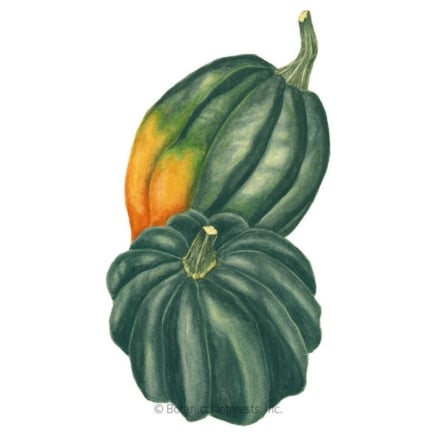
Table King Acorn Winter Squash Seeds
Pink Banana Winter Squash
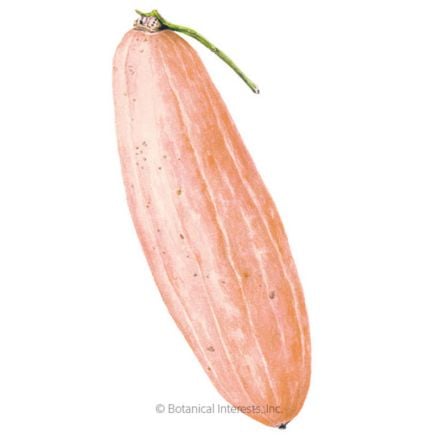
Pink Banana Winter Squash Seeds

About Winter Squash
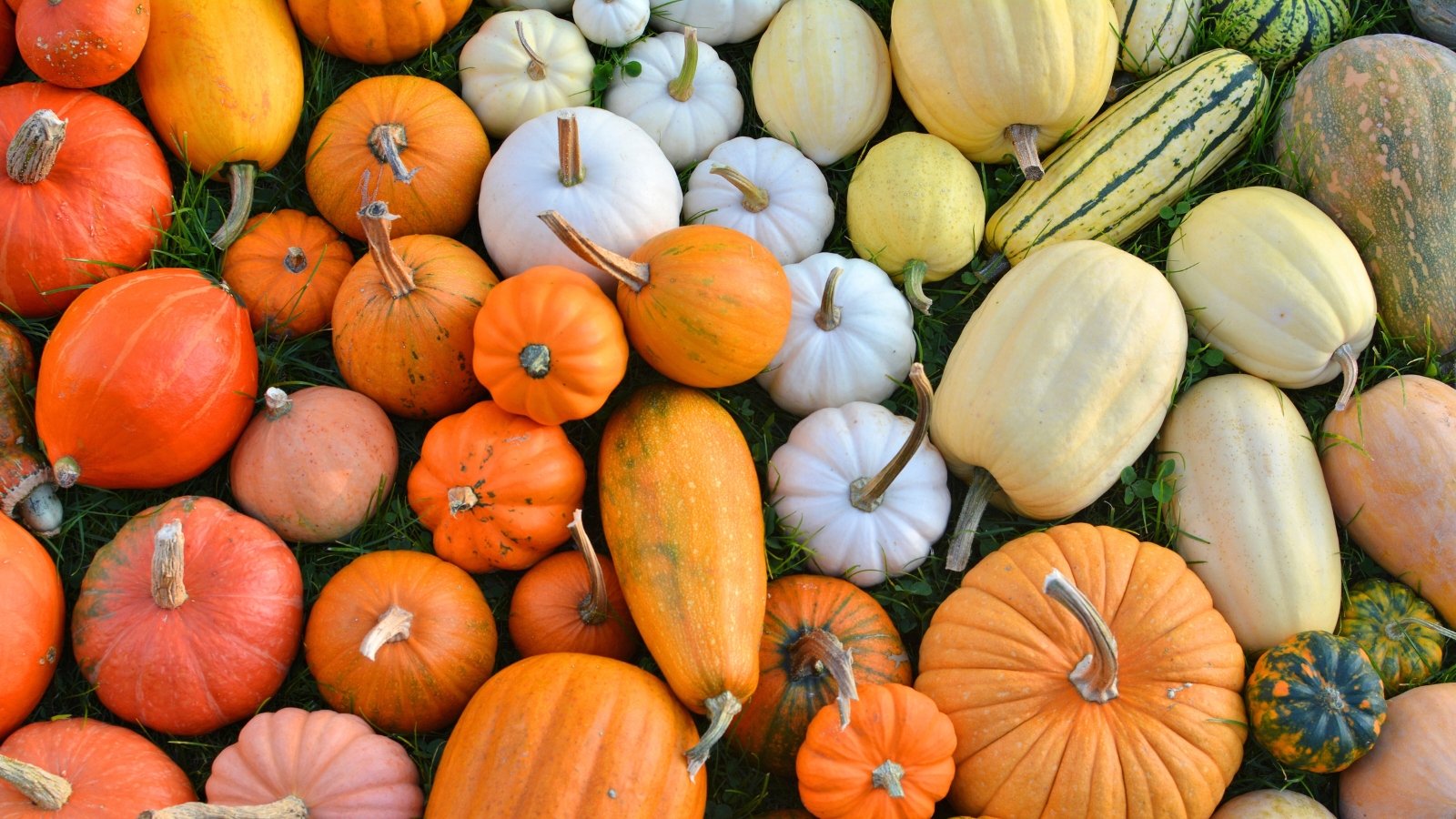 Long-maturing fruits reward patience with hearty meals.
Long-maturing fruits reward patience with hearty meals.Winter squashes mature in late summer and fall, taking time to develop their hefty fruits with thick skins. Types of winter squashes include:
- Acorn
- Butternut
- Delicata
- Hubbard
- Spaghetti
- Pumpkin
Winter selections are usually sown in spring or early summer for an autumn harvest. Vines, either long and sprawling or compact and bushy, run along the ground, on vertical supports like trellises and arches, and in raised beds and containers.
While some take 100 or more days to mature, dwarf varieties may be ready earlier and suit both small space gardens and those with a short growing season.
Winter squashes are in the Cucurbitaceae family with cucumbers, melons, and summer squashes. Cucurbits share the same pests and diseases, so it’s best to separate the group when feasible. Crop rotation benefits the health of each crop, so lingering pests and pathogens don’t have hosts in the same spot season after season.
Optimal growing conditions include:
- Full sun (six or more hours of sunlight daily)
- Rich, well-draining, sandy loams
- Warm conditions; sow seeds when soil temps reach 70-85°F (21-29°C) for best germination and growth
- One to two inches of water per week (rainfall and/or irrigation)
Mark the Days to Maturity
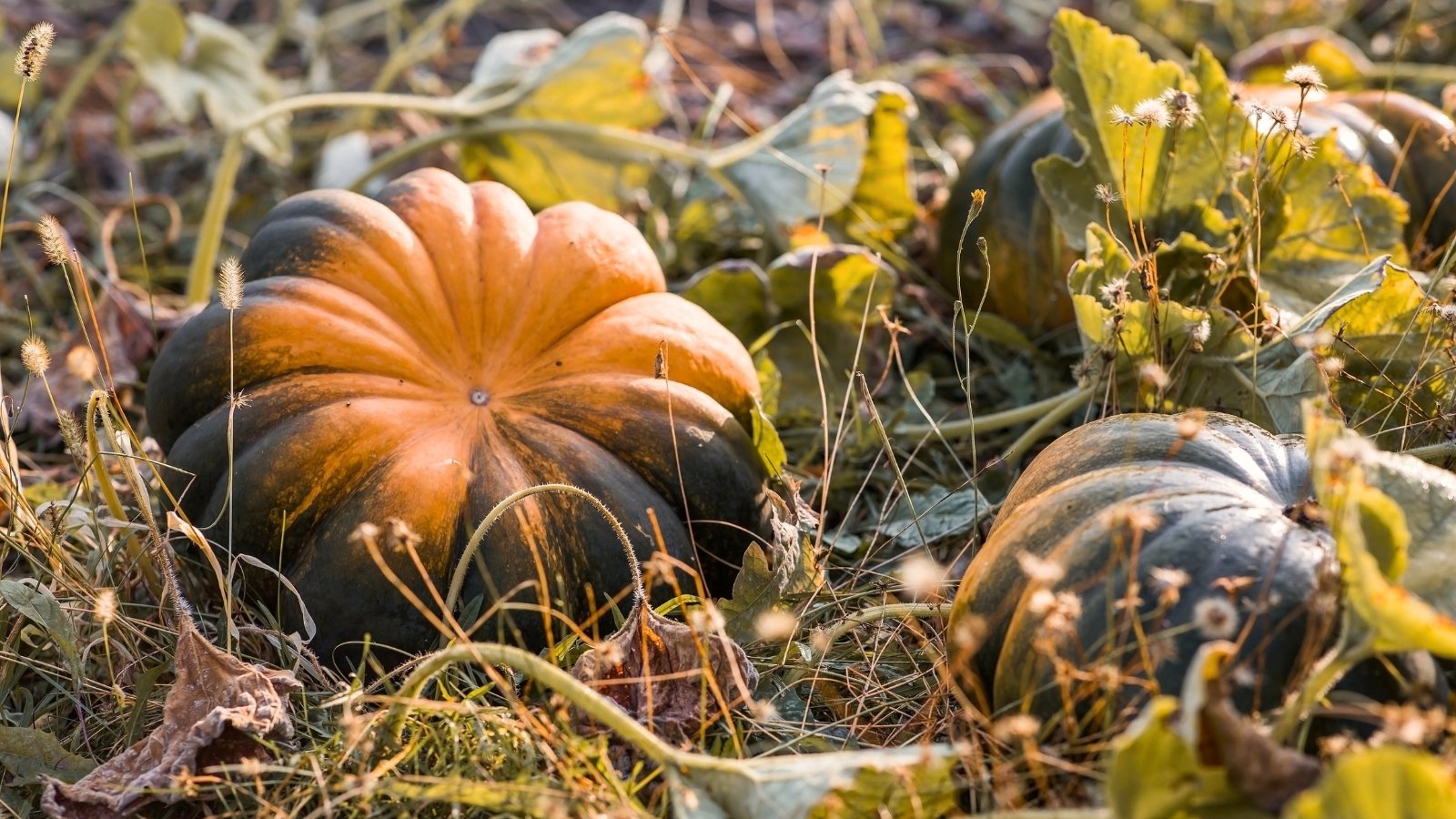 Counting days helps predict when fruits reach ripeness.
Counting days helps predict when fruits reach ripeness.To gauge the time to harvest winter squash, count out the days to maturity from your sowing date. The seed packet lists the number of days to harvest under optimal conditions, and the count offers an estimate of when to expect ripe fruits.
Add several days to account for seasonal variations and weather fluctuations that may impact development. Selections planted in spring and early summer often mature in September and October, usually 80 to 120 days after sowing, depending on the variety.
Beat the Frost
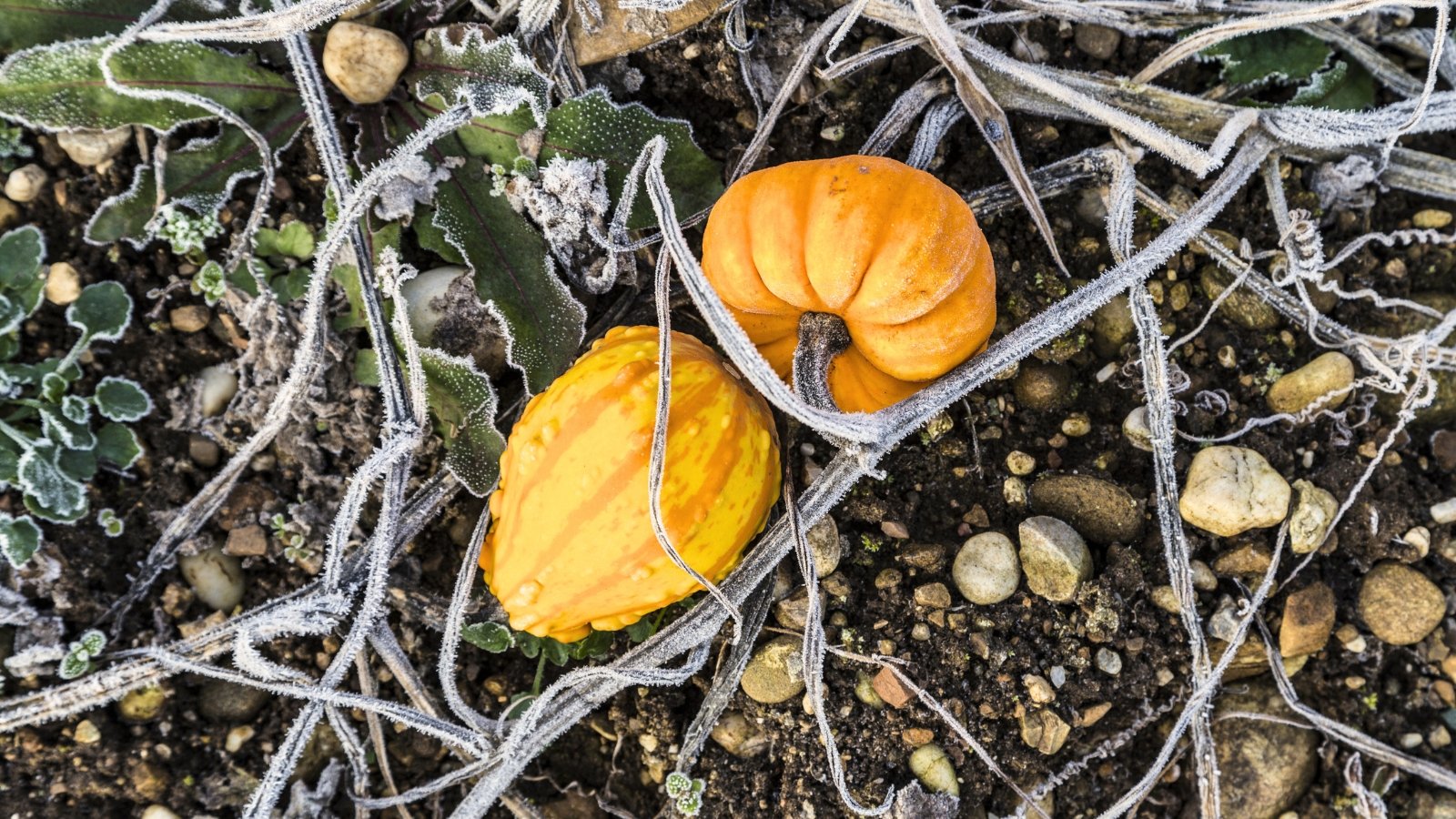 A hard freeze can shorten storage shelf life.
A hard freeze can shorten storage shelf life.Frost on the pumpkins means it’s time to harvest winter squash. Winter squashes are frost-sensitive, doing best in temperatures above 45°F (7°C). They can withstand lower dips, even as low as 35°F (2°C), but need warming temperatures to follow.
Aim to harvest winter squash before fall’s first anticipated frost, or at least before a hard freeze. Those hit with a freeze may recover with time spent at room temperature. Flavor and color may improve in storage, but with frost damage, shelf life may lessen.
Knowing When To Pick
Picking winter squashes when they’re fully mature yields the best eating and storing. Gauging maturity varies by type and is sometimes difficult to tell. So, several visual and physical cues offer signs of peak ripeness.
The good news is that winter squashes continue to ripen off the vine, so if picked a little early, they’ll get better in time as starches convert to sugars. Pro-vitamin A levels may increase, too, as carotenoid pigment increases in storage.
Browning Vines and Corking Stems
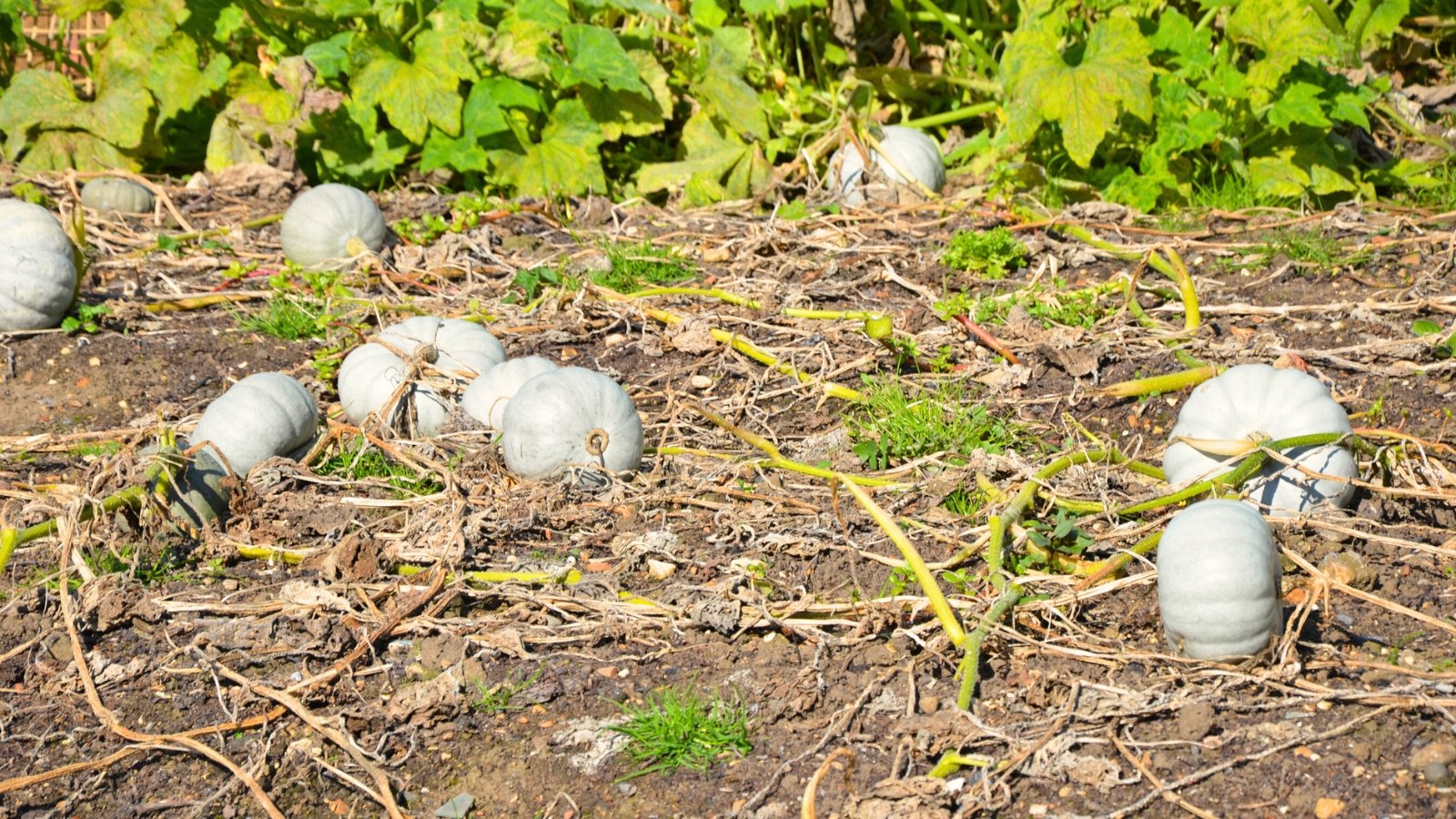 Browning vines signal that fruits are reaching full maturity.
Browning vines signal that fruits are reaching full maturity.Look for brown, drying vines as an indicator of when to harvest winter squash (as long as they aren’t indicating drought or disease). Healthy vines that show browning as fruits reach readiness are a marker to use in coordination with a stem inspection.
Stems that cork are a useful sign in determining maturity. Stems transition from green to brown, showing woodier qualities. Brown streaks appear where the stem meets the fruit. Stems also shrink as they no longer need many nutrients or moisture from the main vine. The rind hardens during this corking phase (the best time to pick).
Color
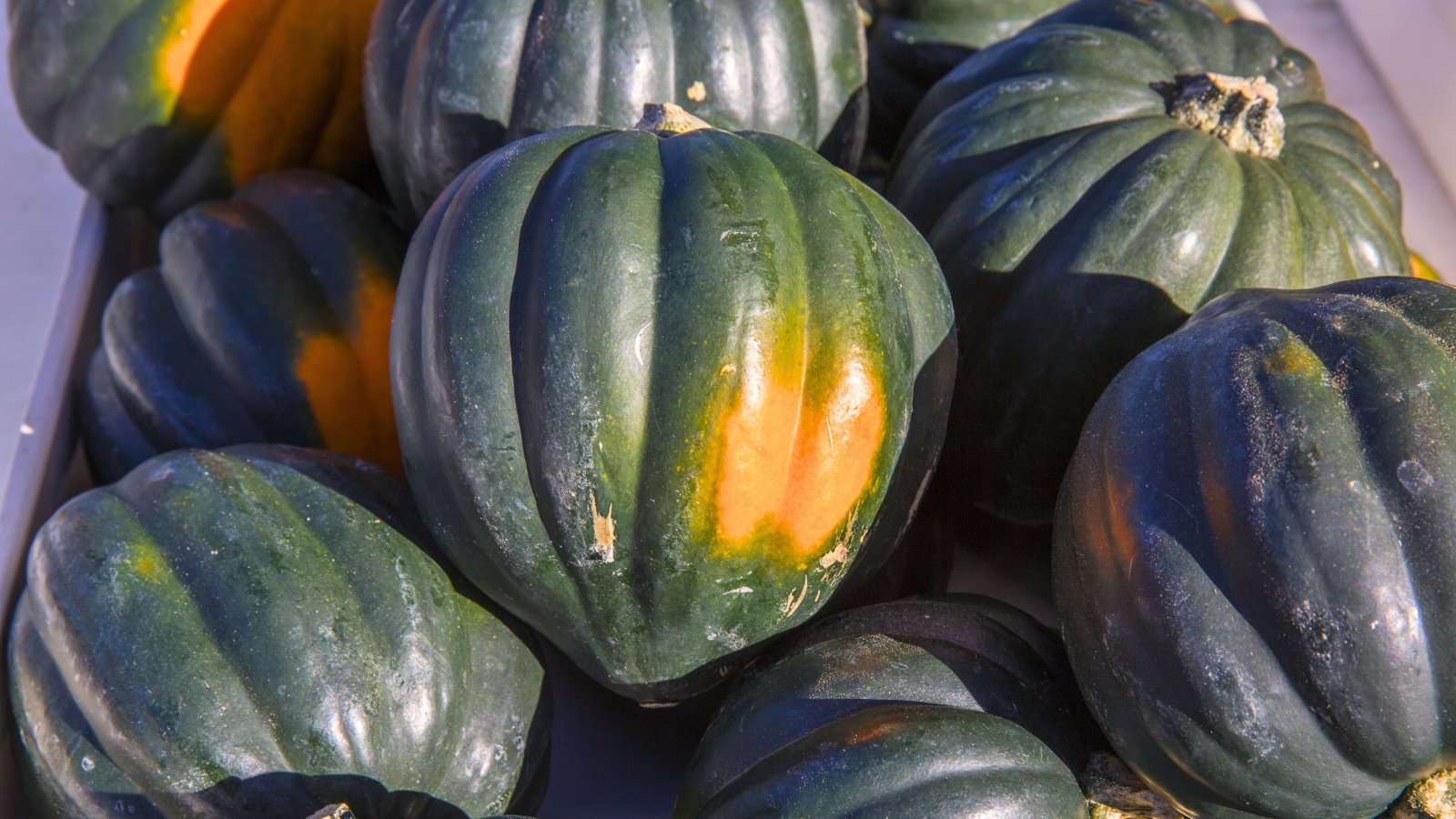 Ground spot darkens as fruits approach peak ripeness.
Ground spot darkens as fruits approach peak ripeness.The color when you harvest winter squash should be deep and even to match the variety’s mature tone. Color change is helpful in pumpkins, as they transition from green to orange. Other winter squashes turn to their final color early, even before they’re ready to harvest. Butternuts may become their final buff tan two to three weeks before maturity.
For some types of winter squashes, the ground spot tells of ripeness. Acorn squashes are fully ripe when the spot where the fruit touches the soil is dark orange. Skin transitions from light to dark green. If the spot isn’t orange at picking, ripening will continue in storage. A fully orange spot at picking, though, is best for enjoying close to harvest time.
Look for a dull cast to the skin, too, for the squashes to be ripe. The rind becomes less glossy and more matte as it reaches maturity.
Firmness
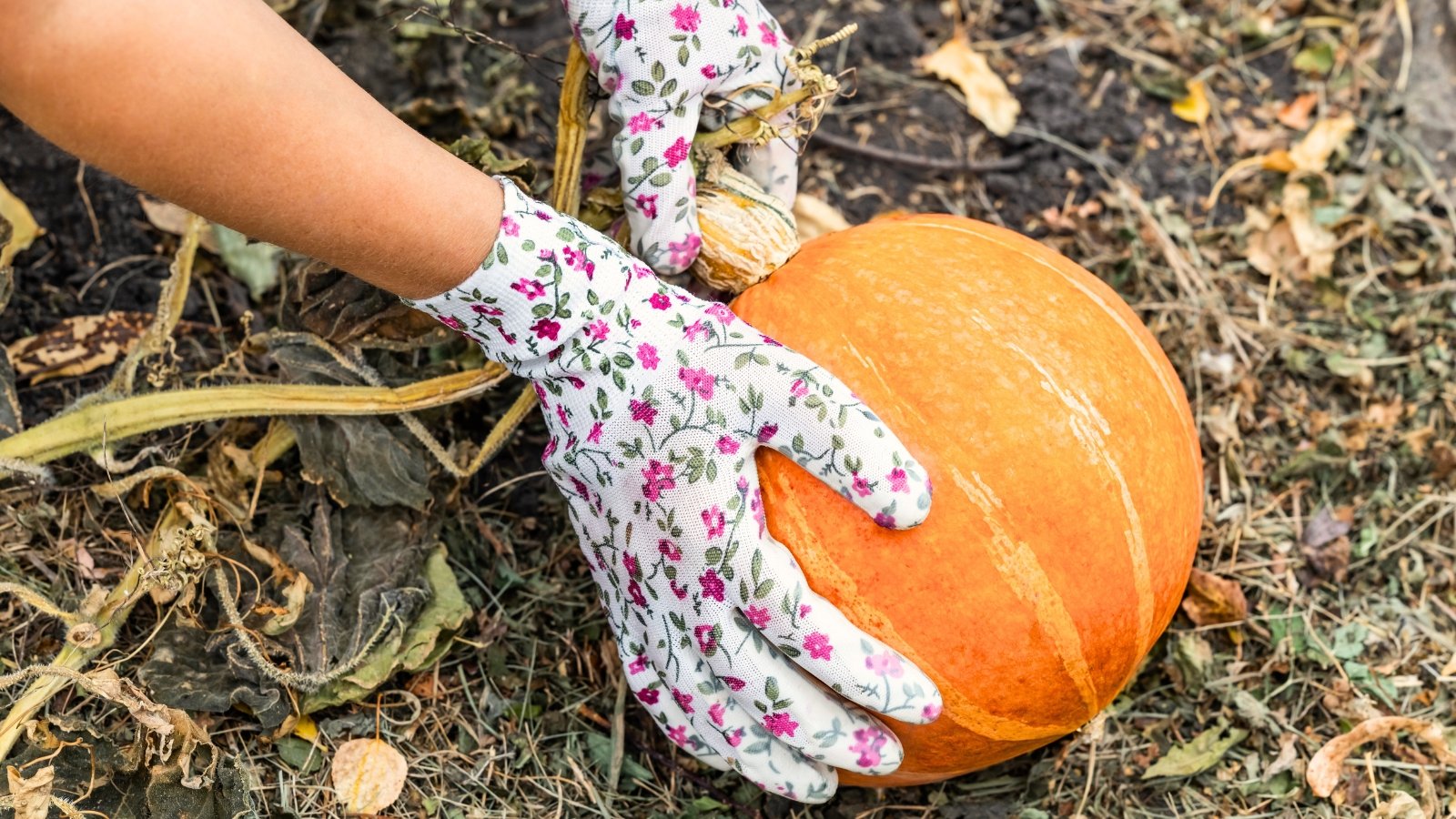 Firm rind and weight show fruits are fully mature.
Firm rind and weight show fruits are fully mature.A hard rind is a good indicator that winter squash is ready to harvest. They’ll be firm against a fingernail test. Score the skin with a fingernail to see if the rind resists marking (if so, it’s ready).
The hefty squashes will also feel weighty. Even small ones, like mini pumpkins, should feel dense.
How To Pick
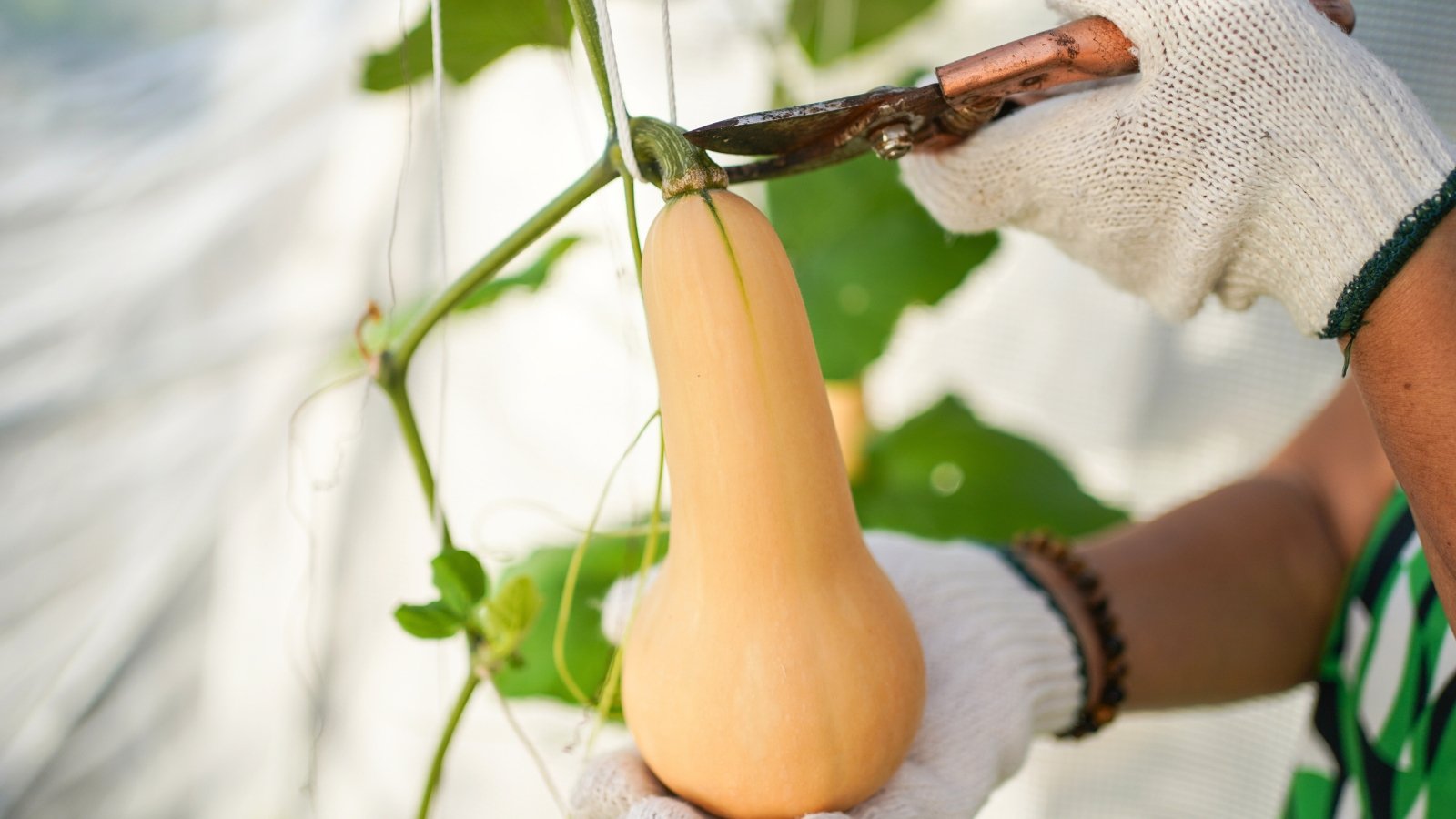 Sharp pruners make clean cuts, protecting fruit longevity.
Sharp pruners make clean cuts, protecting fruit longevity.To harvest winter squash, cut them carefully from the stem with pruners or a sharp knife. Leave about two inches of the stem attached to the fruit to prevent decay and stem-end rot post-harvest. Twisting or pulling can result in the stem separating from the fruit.
Take care with the fruits during harvest to avoid bruising or cutting. Damage can lead to decreased storage life.
Storage
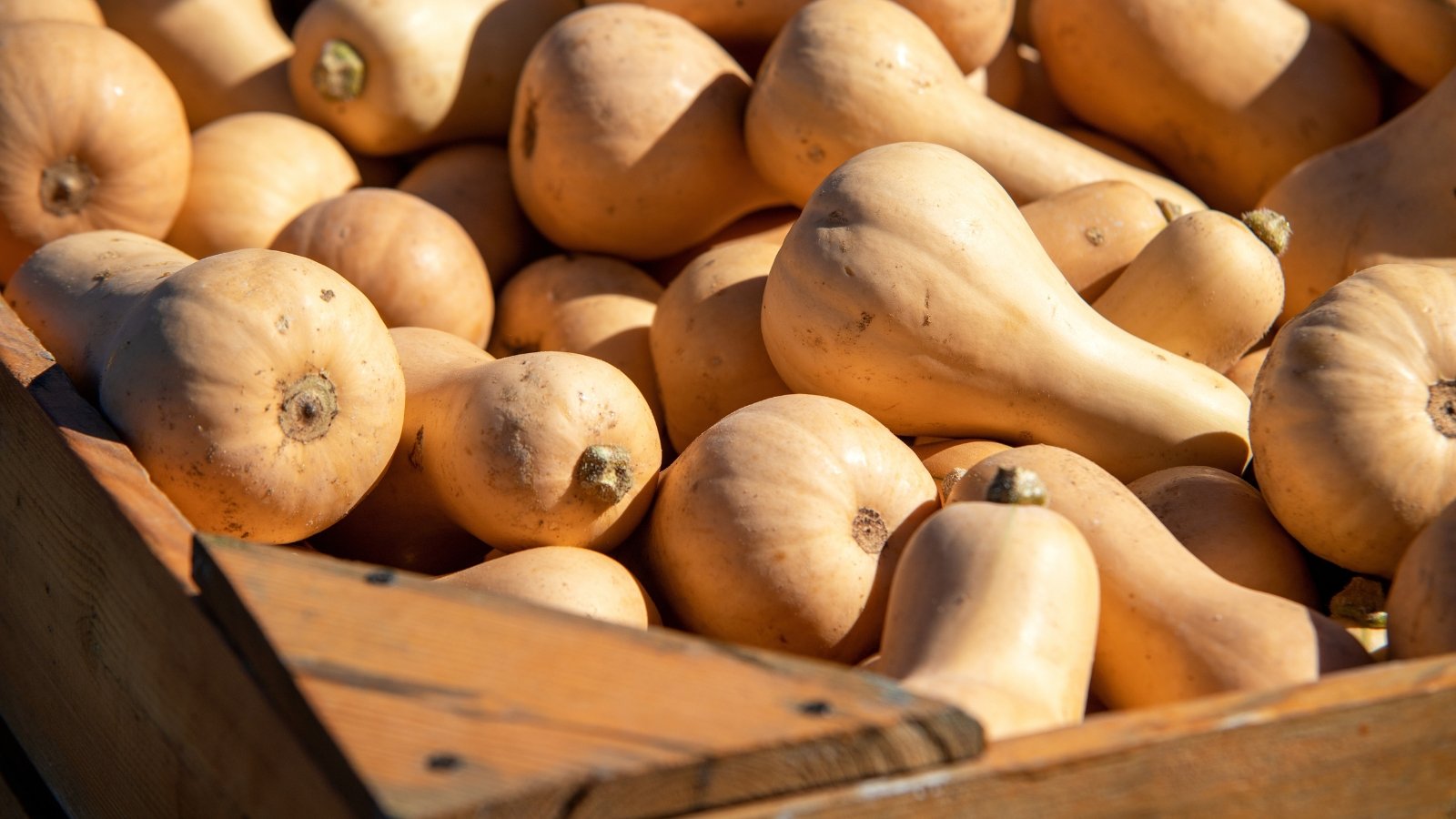 Proper humidity levels keep fruits firm and tasty longer.
Proper humidity levels keep fruits firm and tasty longer.A week at two at 70 to 80°F (21-27°C, or room temperature) promotes the starch-to-sugar conversion for a sweeter flavor. This curing period benefits many winter species except for acorn and delicata. And, keeping them too warm for too long decreases the shelf life.
Ideal storage temperatures are between 50 and 60°F (10-16°C), and a root cellar or basement works well. A relative humidity between 50 and 70% is optimal. Place the fruits in a double layer, or single if space allows, to maintain air circulation and stave off spreading rots.
Storage time varies by type of winter squash, with butternuts lasting two to three months. Acorns last about two months, and hubbards up to six months. Pumpkins can store for up to a year, depending on the variety.
Avoid storing the cucurbits near ripening apples, pears, tomatoes, and other fruits that release ethylene. The gas shortens the shelf life of the squashes.
Winter squashes also take well to preserving through canning, especially as purees, or by freezing. To freeze the squash, boil, steam, or roast it until the pulp is soft. Separate the flesh from the rind, and mash it for storing (except for spaghetti squash, no need to mash).
Let it cool, placing the pan in cold water and stirring to hasten the process. Package the cool mash in an airtight container or bag, leaving half an inch of headspace.
Popular Varieties
Winter squashes bring buttery, nutty flavors to sweet and savory dishes in fall and winter. Save space by growing compact varieties vertically in beds and containers. Or, offer plenty of room for long, sprawling varieties to run.
‘Honeynut’
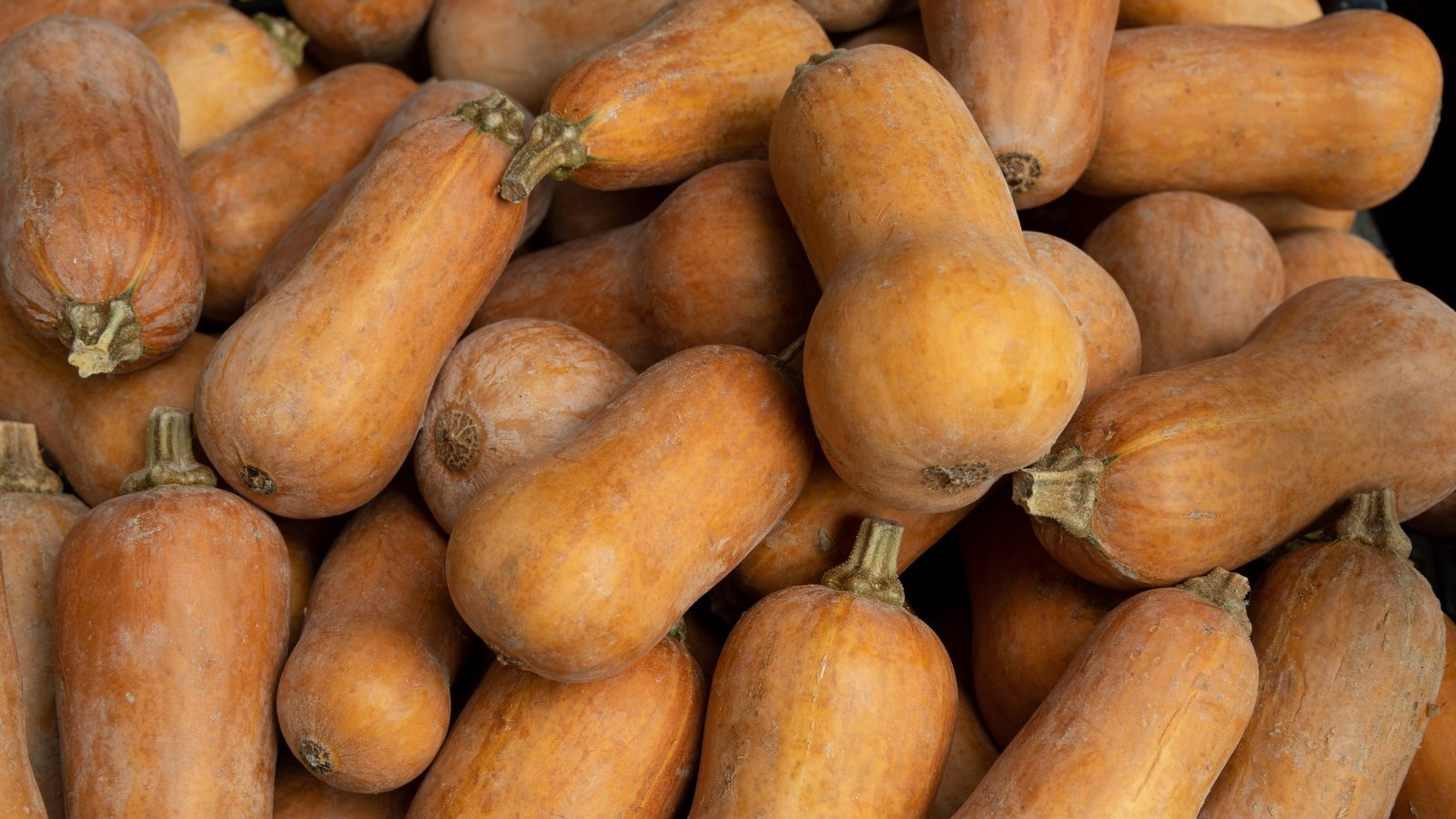 Resistant vines handle squash borer and mildew well.
Resistant vines handle squash borer and mildew well.‘Honeynut’ is a Cornell hybrid that crosses butternut and buttercup (two of the sweetest squash varieties) for superlative sweetness and a smooth texture. The moschata selection shows good squash vine borer and powdery mildew resistance. Their thick skins and smooth stems make them less accessible to the destructive pests in the egg-laying and larval phases.
‘Honeynut’ produces small fruits, at four to five inches long, that pack the flavor. Dwarf, bushy vines make them ideal for growing vertically and in small spaces.
The petite butternuts begin mottled green and ripen to mellow orange-red. The fruits are ready in 110 days and store for up to six months.
‘Delicata’
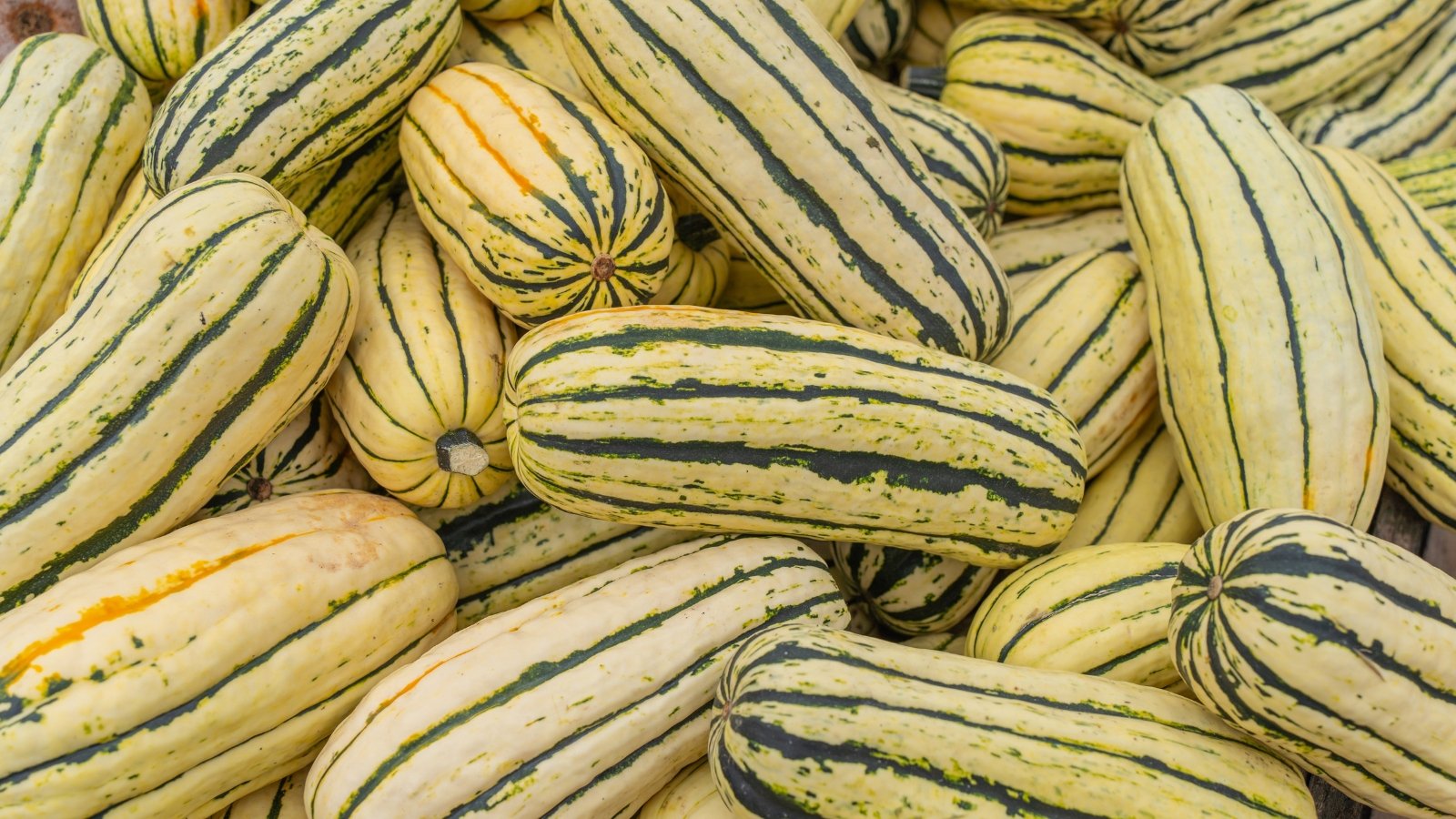 Enjoy fruits quickly because thin skins limit storage time.
Enjoy fruits quickly because thin skins limit storage time.‘Delicata’ is a favorite and is among the sweetest squash varieties. An heirloom, ‘Delicata’ is from 1894 and boasts a high sugar content and fine-textured, golden interiors. Fruits are sweet right off the vine with a thin skin for easy cutting in the kitchen. There’s no need for peeling, as the skin is edible and nutty.
‘Delicata’ produces elongated loaves that are creamy-white with orange tones and dark green stripes and flecks. They reach eight inches long and four inches wide and weigh one to three pounds. Due to the thin skins, storage time is only a few months, so enjoy this one closer to harvest to warm up chilly fall and winter evenings.
Look for Cornell’s ‘Bush Delicata’ for improved disease resistance. ‘Sugar Loaf’ and ‘Honey Boat’ are bred for sweetness.
‘Table King’
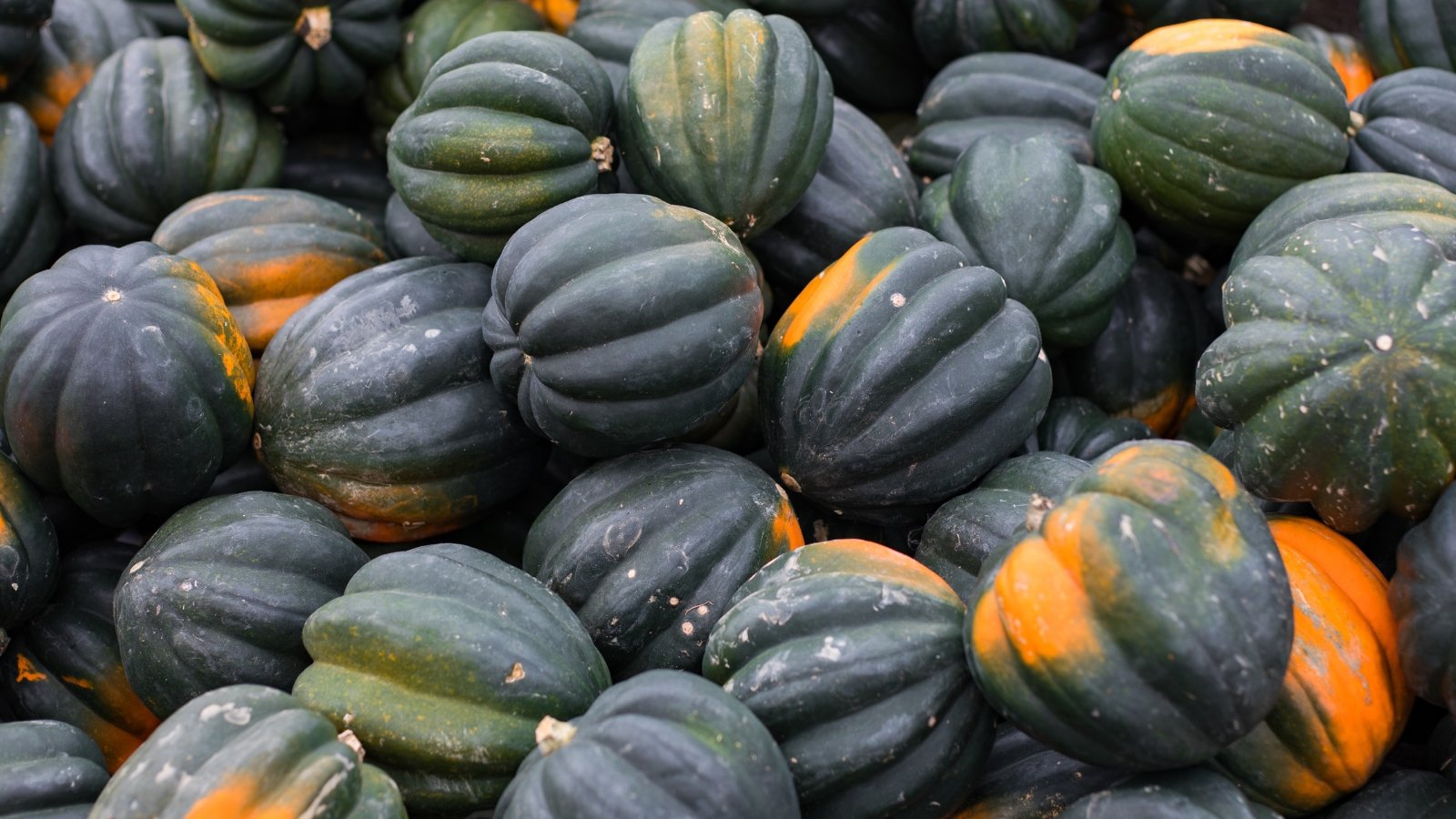 Shiny dark green skins show quality and health.
Shiny dark green skins show quality and health.‘Table King’ is an early-maturing acorn squash from the University of Connecticut in 1974. The compact hybrid is an All-America Selections winner for its quality flavor, dwarf vines, and long storage life. ‘Table King’ is the ideal serving size for stuffing and matures in about 80 days.
‘Table Queen’ is an earlier variety from the Iowa Seed Company in 1913. The historic acorns have shiny, dark green skins and prominent ridging. The interior flesh is a rich, creamy yellow-orange. With a sugary pulp, both ‘King’ and ‘Queen’ acorns are perfect for baking.
‘Pink Banana’
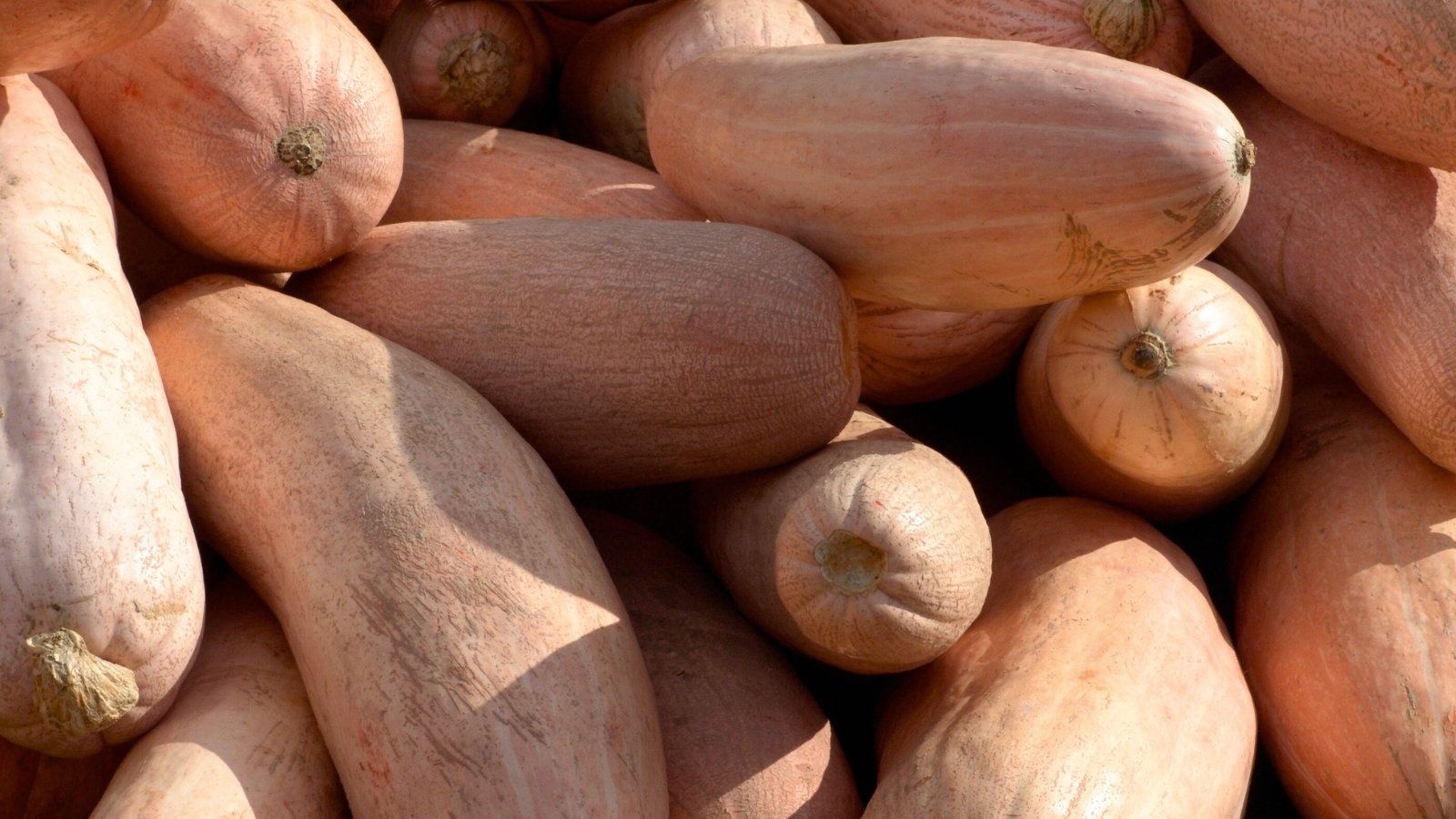 Salmon-pink fruits brighten any autumnal garden display.
Salmon-pink fruits brighten any autumnal garden display.‘Pink banana’ makes a statement in the autumnal display as a large, salmon pink variety that reaches 18 to 24 inches long. Its sugary, tender interior is made for baking into pies or enjoying as a side dish.
Each fruit weighs 10 to 12 pounds and has a bright golden-orange interior. The seed cavity is narrow, leaving more room for the “meat.”
Native to Argentina and Uruguay, ancient cultures grew banana squash, as did American pioneers. ‘Pink Banana’ brings a historic staple to the edible landscape and fall harvest.
‘Red Kuri’
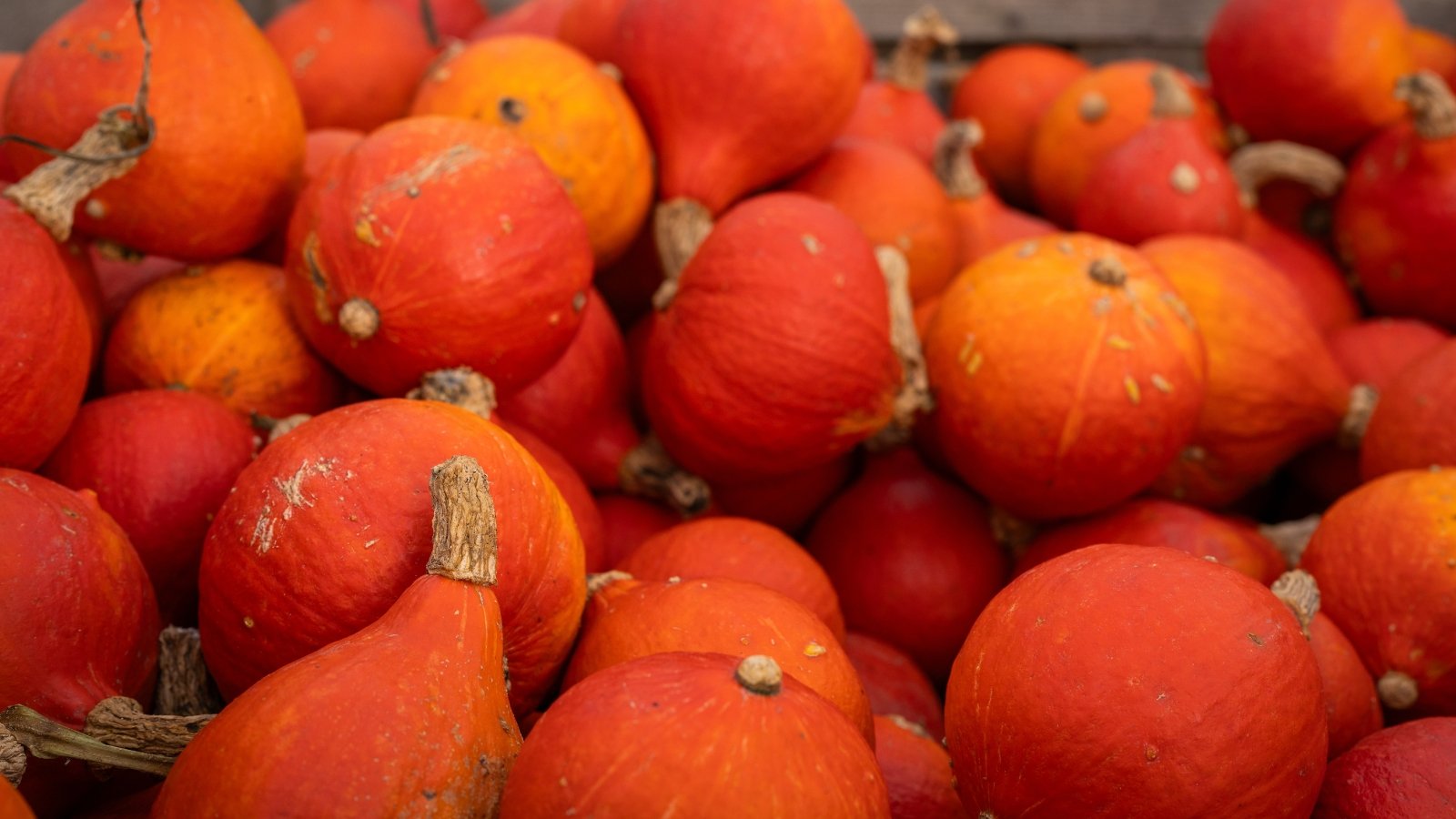 Quick-growing vines suit short, cold growing seasons.
Quick-growing vines suit short, cold growing seasons.‘Red Kuri’, also called ‘Orange Hokkaido’ or ‘Baby Red Hubbard,’ is a Japanese variety with a creamy texture and chestnut flavor (kuri means “chestnut”). The melon-orange squashes are ideal for steaming, roasting, and baking. Some say they’re as sweet as and even better than pumpkins.
‘Red Kuri’ suits small gardens, growing vertically on a trellis, and containers. The vines produce two to five teardrop fruits, each weighing three to four pounds.
Ready in about 95 days, ‘Red Kuri’ is a good option for short-growing seasons in cold climates. They develop relatively quickly as winter cucurbits go, on compact forms.
Frequently Asked Questions
Winter squash that lingers past peak picking time is susceptible to frost damage in cold climates. A hard freeze can damage the internal tissues of the squash. Potential diseases like rot from excess moisture and pest damage also increase the longer the fruit sits in maturity.
Many winter squashes benefit from 10 to 20 days at room temperature right after harvesting. The warm conditions allow starches to convert to sugars for better flavor. After the curing timeframe, move the fruits to a cool, dry location like a basement for storage. Acorn, delicata, and sweet dumpling don’t need curing post-harvest.


 1 day ago
3
1 day ago
3


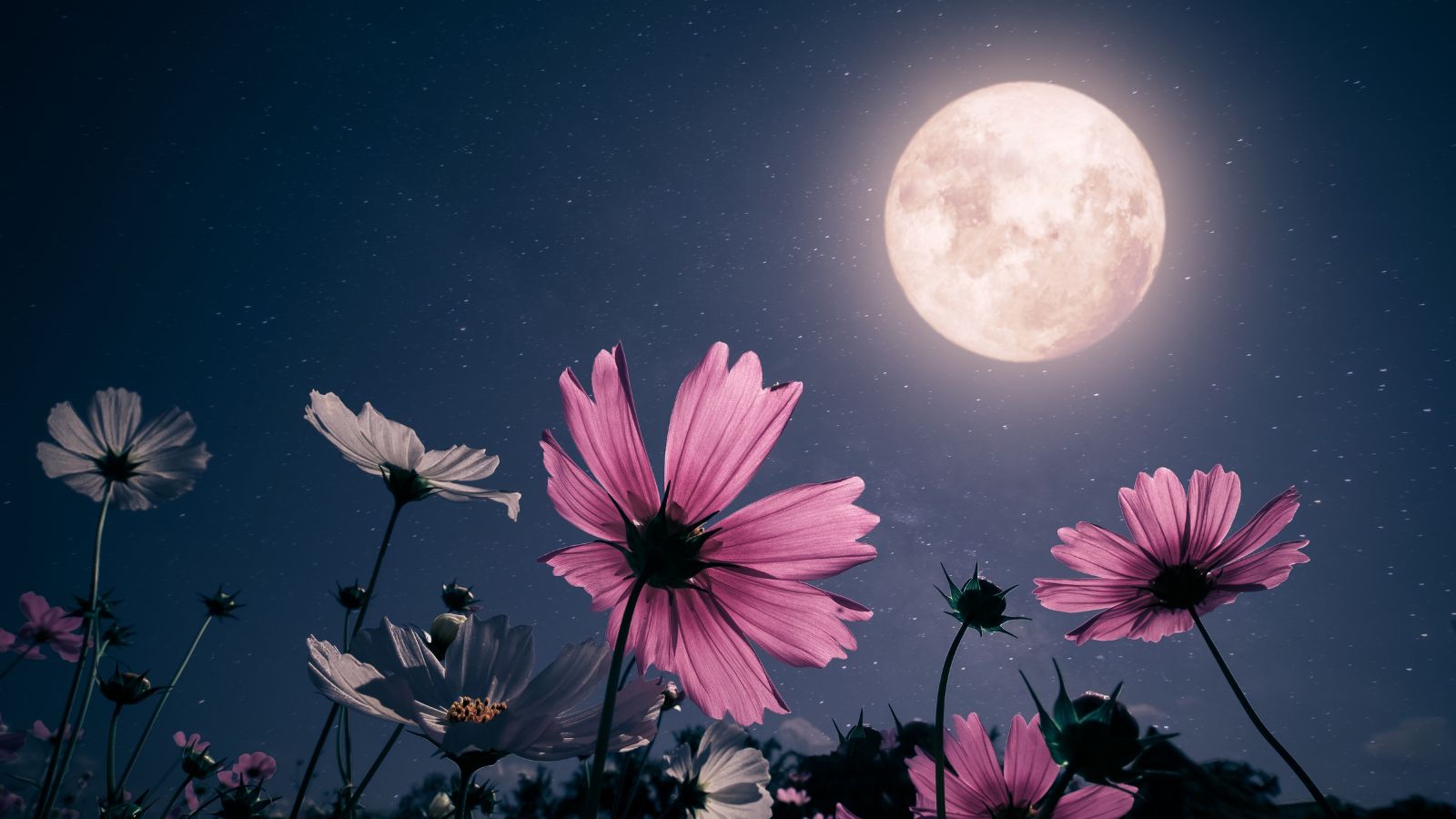

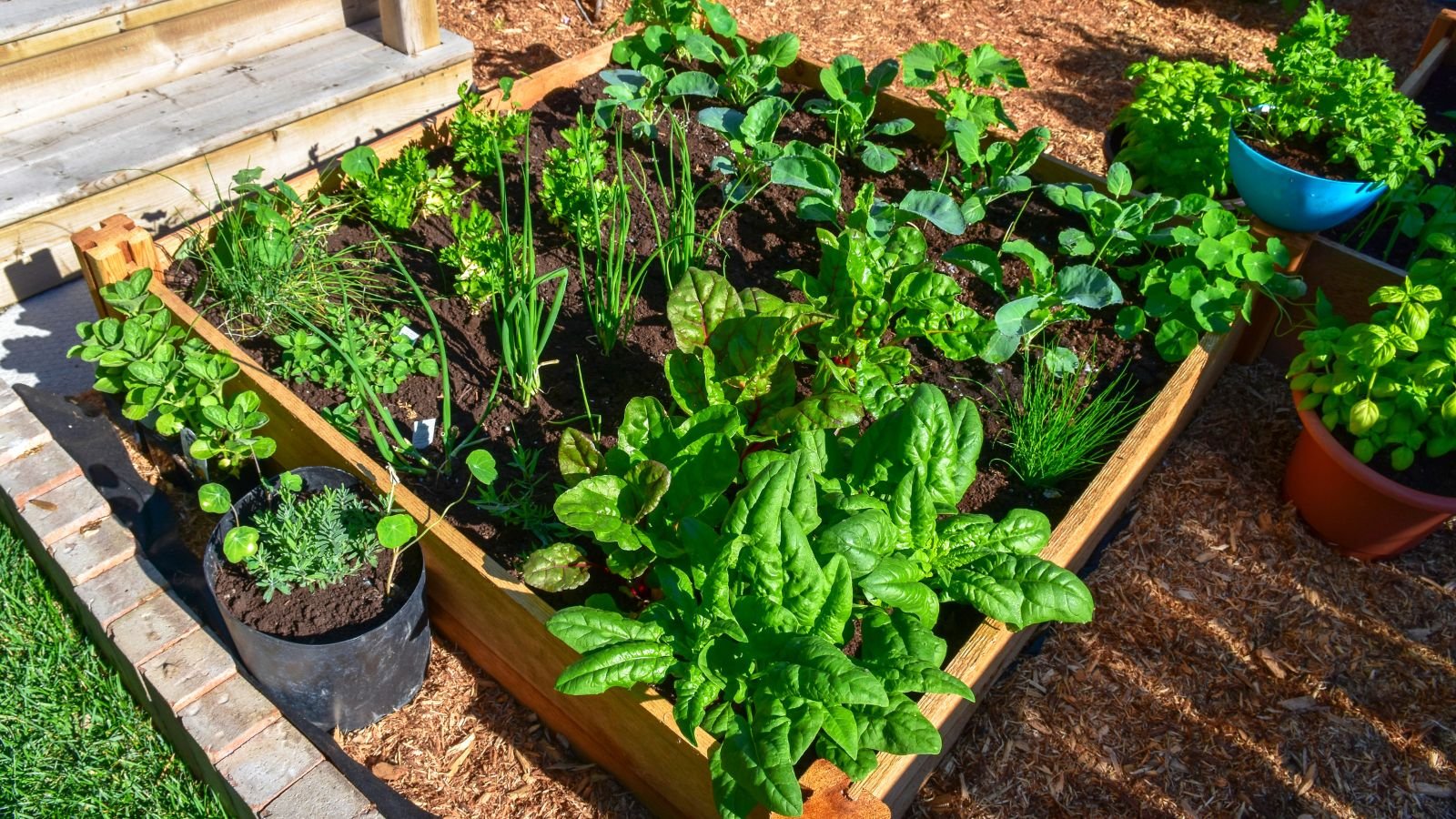
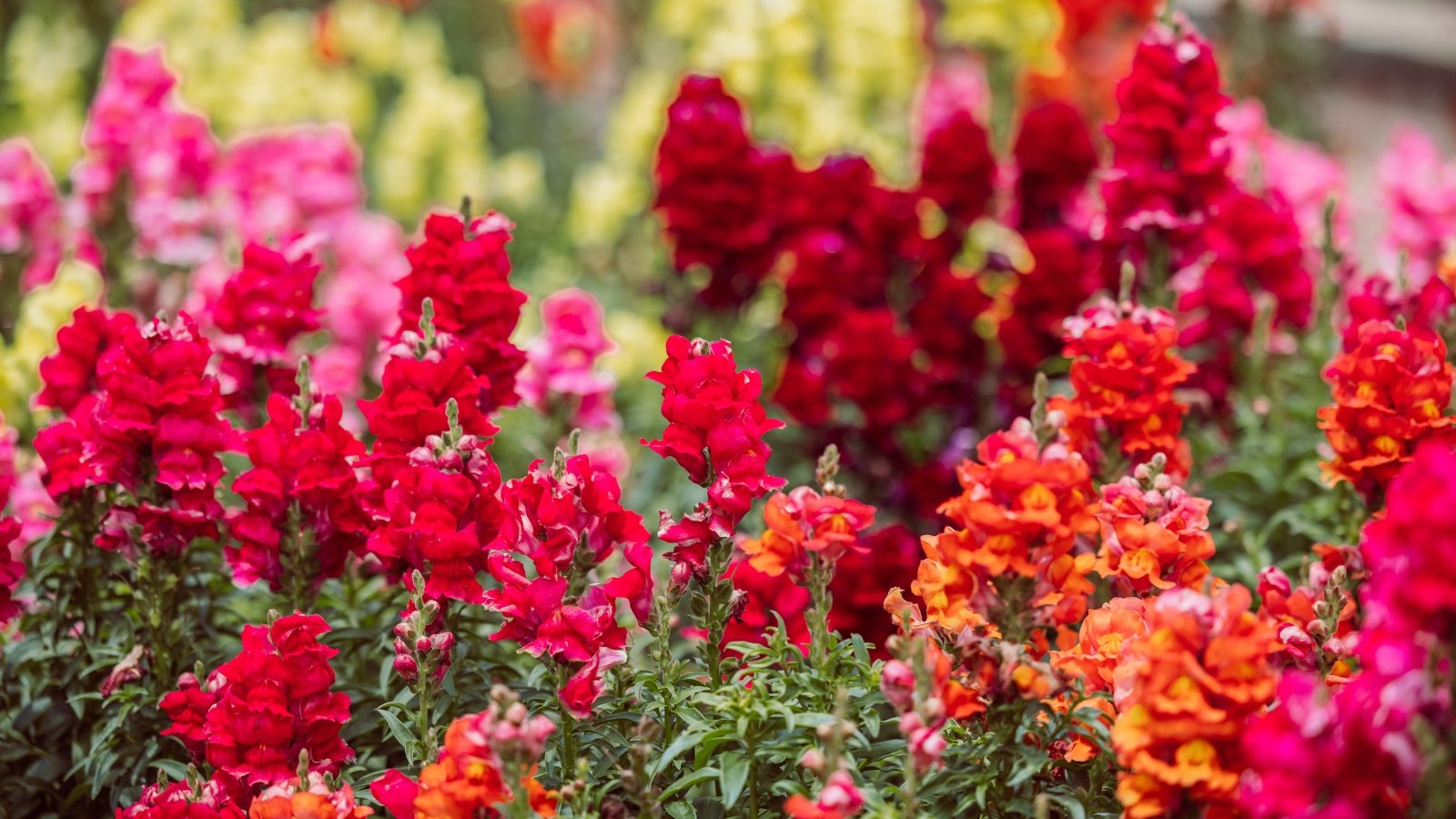















 English (US) ·
English (US) ·  French (CA) ·
French (CA) ·